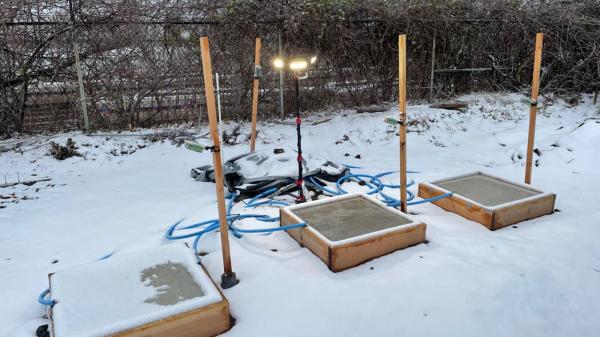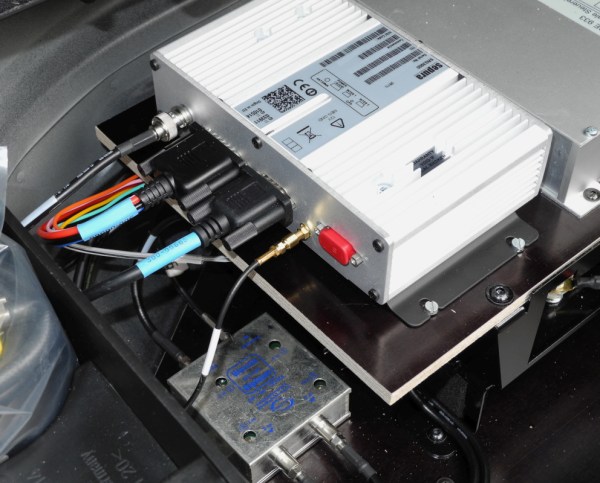So you say you missed the Great Solar Storm of 2024 along with its attendant aurora? We feel you on that; the light pollution here was too much for decent viewing, and it had been too long a day to make a drive into the deep dark of the countryside survivable. But fear not — the sunspot that raised all the ruckus back at the beginning of May has survived the trip across the far side of the sun and will reappear in early June, mostly intact and ready for business. At least sunspot AR3664 seems like it’s still a force to be reckoned with, having cooked off an X-class flare last Tuesday just as it was coming around from the other side of the Sun. Whether 3664 will be able to stir up another G5 geomagnetic storm remains to be seen, but since it fired off an X-12 flare while it was around the backside, you never know. Your best bet to stay informed in these trying times is the indispensable Dr. Tamitha Skov.
infrastructure41 Articles
Concrete Clears Its Own Snow
Humans are not creatures well suited to cold environments. Without a large amount of effort to provide clothing, homes, and food to areas with substantial winters, very few of us would survive. The same is true of a lot of our infrastructure since things like ice, frost heave, and large temperature swings can all negatively impact buildings, roadways, and other structures. A team at Drexel University in Pennsylvania has created a type of concrete they hope might solve some issues with the material in cold climates.
Specifically when it comes to sidewalks and roadways, traditional methods of snow and ice removal such as plowing and salting are generally damaging to the surface material, with salting additionally being damaging to vehicles. Freeze-thaw cycles aren’t kind to these surfaces either. This concrete, on the other hand, contains a low-temperature liquid paraffin which releases heat when it has a phase change, from a liquid to a solid. By incorporating the material into the concrete, it can warm itself as temperatures drop, maintaining a temperature above freezing to melt ice and snow. The warming effect isn’t indefinite, but lasts a significant amount of time during testing.
Public Power, WiFi, And Shelter
In the US, we’re starting to see some pushback against hostile architecture, and in this vein, [benhobby] built a swanky public power and Wi-Fi access point.
This beautiful piece of infrastructure has 400 watts of solar plugged into 1.2 kWh of battery storage, and can dispense those electrons through any of its 120 VAC, USB-C, or USB-A plugs. The uprights are 3″ aluminum tubing attached to a base consisting of cinder blocks and HDPE panels. Power receptacles are housed in 3D printed enclosures with laser cut acrylic fronts. Three outdoor lights illuminate the stop at night, triggered by a photosensor.
The electronics and battery for the system, including the networking hardware, are in a weatherproof box on each side that can be quickly disconnected allowing field swaps of the hardware. Troubleshooting can then take place back at a workshop. One of the units has already been deployed and has been well-received. [benhobby] reports “There’s one in the wild right now, and it gets plenty of visitors but no permanent tenants.”
Want to see some more interesting hacks for public infrastructure? Check out this self-cooling bus stop, this bus bloom filter, or this public transit display.
Hackaday Links: August 6, 2023
“Have you tried turning it off and on again?” is a common tech support maneuver that everyone already seems to know and apply to just about all the wonky tech in their life. But would you tell someone to apply it to a reservoir? Someone did, and with disastrous results, at least according to a report on the lead-up to the collapse of a reservoir in the city of Lewiston, Idaho — just across the Snake River from Clarkston, Washington; get it? According to the report, operators at the reservoir had an issue crop up that required a contractor to log into the SCADA (supervisory control and data acquisition) system running the reservoir. The contractor’s quick log-in resulted in him issuing instructions to local staff to unplug the network cable on the SCADA controller and plug it back in. Somehow, that caused a variable in the SCADA system — the one storing the level of water in the reservoir — to get stuck at the current value. This made it appear that the water level was too low, which lead the SCADA system to keep adding water to the reservoir, which eventually collapsed.
Serious Vulnerability In European Trunked Radio System
Trunked radio systems can be difficult to wrap one’s mind around, and that’s partially by design. They’re typically used by organizations like police, firefighters, and EMS to share a limited radio frequency band with a much larger number of users than would otherwise be able to operate. From a security standpoint, it also limits the effectiveness of scanners who might not know the control methods the trunked systems are using. But now a global standard for encrypted trunked radio systems, known as TETRA, has recently been found to have major security vulnerabilities, which could result in a lot more headache than disrupted voice communications.
One of the vulnerabilities in this radio system was a known backdoor, which seems to have been protected largely via a “security through obscurity” method. Since the system has been around for about 25 years now, it was only a matter of time before this became public knowledge. The backdoor could allow non-authorized users to snoop on encrypted radio traffic. A second serious vulnerability, unrelated to this backdoor, would further allow listening to encrypted voice traffic. There are a few other minor vulnerabilities recently uncovered by the same security researchers who found these two major ones, and the current recommendation is for anyone using a TETRA system to take a look to see if they are impacted by any of these issues.
Part of the reason this issue is so concerning is that these systems aren’t just used for encrypted voice among first responders. They also are used for critical infrastructure like power grids, rail networks, and other systems controlled by SCADA. This article from Wired goes into much more detail about this vulnerability as well, and we all know that most of our infrastructure already needs significant help when it comes to vulnerabilities to all kinds of failure modes.
Thanks to [cfacer] and [ToniSoft] who sent these tips!
Photo via Wikimedia Commons.
Hackaday Links: June 18, 2023
Will it or won’t it? That’s the question much on the minds of astronomers, astrophysicists, and the astro-adjacent this week as Betelgeuse continued its pattern of mysterious behavior that might portend a supernova sometime soon. You’ll recall that the red giant star in the constellation Orion went through a “great dimming” event back in 2019, where its brightness dipped to 60% of its normal intensity. That was taken as a sign that perhaps the star was getting ready to explode — or rather, that the light from whatever happened to the star 548 years ago finally reached us — and was much anticipated by skywatchers, yours truly included. As it turned out, the dimming was likely caused by Betelgeuse belching forth an immense plume of dust, temporarily obscuring our view of its light. Disappointing.
Those who gave up on the hope of seeing a supernova might have done so too fast, though, because now, the star seems to be swinging the other way and brightening. It briefly became the brightest star in Orion, nearly outshining nearby Sirius, the brightest star in the sky. So what does all this on-again, off-again business mean? According to Dr. Becky, a new study — not yet peer-reviewed, so proceed with caution — suggests that the star could go supernova in the next few decades. The evidence for this is completely unrelated to the great dimming event, but by analyzing the star’s long history of variable brightness. The data suggest that Betelgeuse has entered the carbon fusion phase of its life, a period that only lasts on the scale of a hundred years for a star that size. So we could be in for the ultimate fireworks show, which would leave us with a star brighter than the full moon that’s visible even in daylight. And who doesn’t want to see something like that?
Snow Plowing By Bicycle
There are few challenges more difficult or dangerous than trying to get around the majority of North American cities by bicycle. Not only is the bicycle infrastructure woefully inadequate for safe travel (if it exists at all), but it’s often not maintained to any reasonable standard, either. This goes double in colder areas, where bike paths can essentially become abandoned in the winter after a snowfall. [Phil] found himself in this situation recently after a snowfall in western Canada and decided to DIY his own bike-powered snowplow to help keep his bike paths cleared.
The plow is built around an electric-assisted cargo bicycle, which is almost as rare in North America as bicycle infrastructure itself, but is uniquely suited to snowplow duty. It has a long wheelbase and a large front cargo area that can be weighed down if needed to ensure the plow makes good contact with the ground. The plow itself is built out of sections of plastic 55-gallon drums, which have been cut into two scooping sections and attached to the bike with a wooden 2×4 frame. The plow can be raised or lowered with a ratchet strap mechanism, and the plastic scoop skips over bumps in the path with relative ease.
With this relatively simple mechanism attached to his bike, [Phil] can make sure the trails that he frequents around Vancouver are more suitable for bike travel in the winter. Riding a bicycle through the winter, even in the coldest of climates, is not that difficult with the right support and investment in infrastructure, and this build is the best DIY solution we’ve seen to bicycle infrastructure support outside of adopting something like this remote-controlled snowblower to the job.















